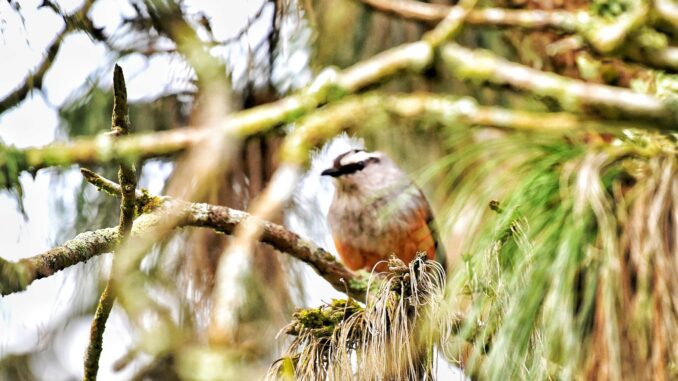
Little did I know of the interesting things about this bird when I photographed it in Kodaikanal. This bird is found only in the Palani Hills range and is categorised as ‘near threatened’. This is the Palani Laughing Thrush. (Montecincla fairbanki) (பழனி சிரிப்பான்).
It was discovered in Kodaikanal by Rev. Samuel Bacon Fairbank in the 1800s and so the name Fairbanki. While all the laughing Thrushes have white eyebrows, the Palani Laughing Thrush is believed to have a slightly longer one. Further it can be differentiated by the brown to ash brown colouring below their beak which has been termed the ‘brown bib’ and their dark brown to almost black crown. So the Palani Laughing Thrush can be identified by their Dark Brown crowns, white eyebrows and brown bibs. Birding could not have been made more fun and easier than this.

There are three more species of Laughing Thrushes which are found only in the Western Ghats, which is a hot spot of bio-diversity.
More interesting is how these Laughing Thrushes became different species. These birds lived above 3500 ft in the mountains. These high peaks or sky islands as they are known became their isolated mountain habitats from which one group could not interact with the other group. They mated within the group and adapted to their unique surrounding and, over time, differentiated into separate species. This type of speciation is called allopatric speciation, where the geographic isolation leads to development of a new species.

And by a random mutation, the longer white eyebrows, the darker crown and the brown bib appeared. Mutation is a basic biological process of cell copying itself. During this process some random errors happen, when a minute bit of the cell’s DNA is weakly copied or some bit of it is even left out. This random error leads to slight changes in plumage colour or other minor traits in the bird. And now natural selection or sexual selection play their part. This changed plumage may be naturally more suitable for the local unique foliage and probably it hides them from local predators or helps them hunt better and thus they become successful survivors. Or perhaps this plumage was more attractive to the birds themselves and they ended up pairing with other such birds with these colour plumages. So this process of natural and sexual selection leads to changes in the bird species itself. And now we have the Palani Laughing thrush with longer white eyebrows, darker crowns and brown bibs.

Montane Laughing Thrushes of the Western Ghats became the Palani Laughing Thrush and the Nilgiris Laughing Thrush, and then further into Banasura and Travancore Laughing Thrushes. The last two being categorised as two different species only as recently as 2017 by Bird Life International.
There are now four species of Laughing Thrushes which are endemic to different parts of the Western Ghats of India.

Leave a Reply